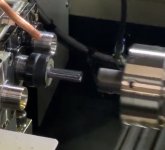Nerdlinger
Stainless
- Joined
- Aug 10, 2013
- Location
- Chicago, IL
Please see the attached picture. I am holding .750" round annealed 4340 in my sub with about .8" stick out. I am using a .375" diameter 4-flute carbide end mill to interpolate a .415" wide slot all the way through the part X .675" deep in Z (multiple passes in Z, btw.) The live em is held in a ER16 collet. At first it was chattering like a son of a bitch. Changing the feed didn't work, but lowering the RPM's on the live end mill sure did. I started at 400SFM and am now all the way down to about 150SFM @ .0025ipt. It sounds great and looks great.
So here's my Q: Even though it isn't any faster, will the carbide still last longer than HSS when run at the same HSSish parameters? If running carbide that slow is going to ruin it maybe I'll just try an HSS cutter...
Thank you!

So here's my Q: Even though it isn't any faster, will the carbide still last longer than HSS when run at the same HSSish parameters? If running carbide that slow is going to ruin it maybe I'll just try an HSS cutter...
Thank you!






